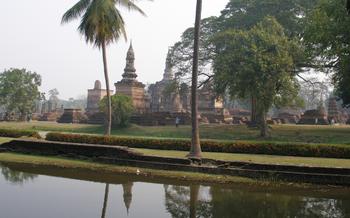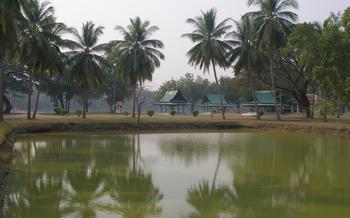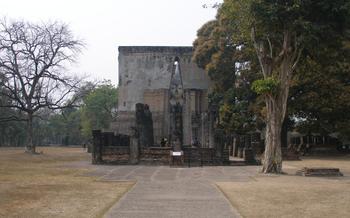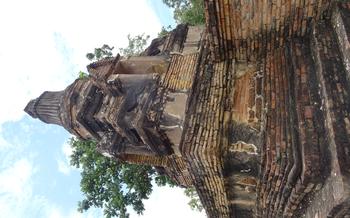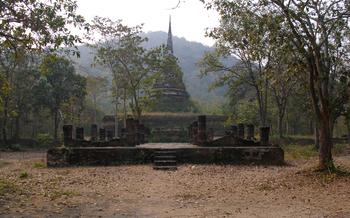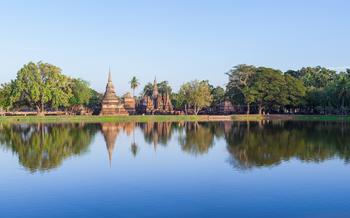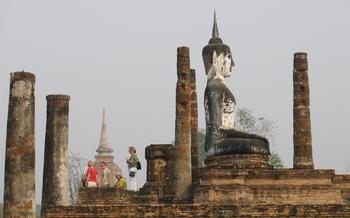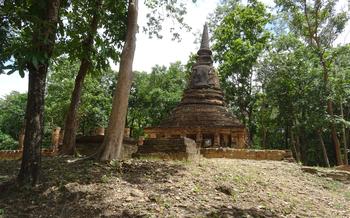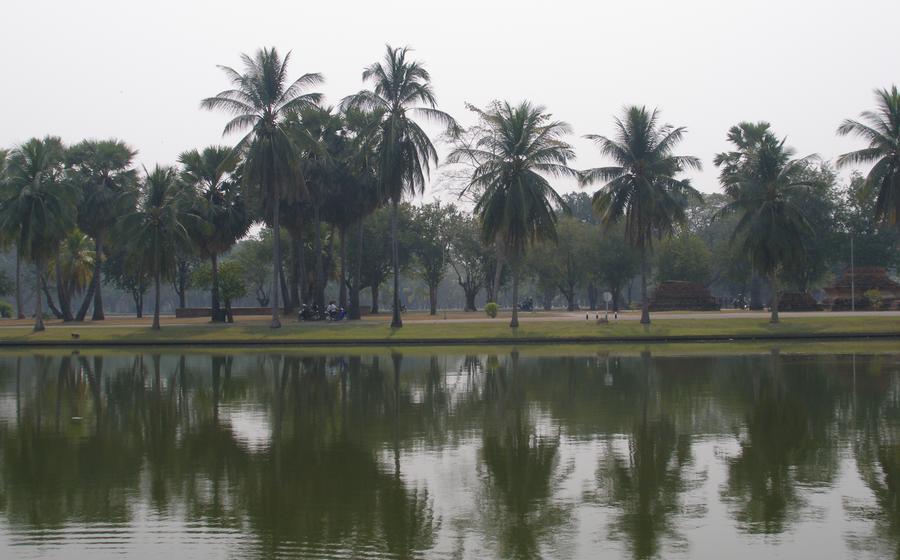
Wat Traphang Tia
- The Ruins of Wat Traphang Tia: A Journey into History and Serenity
- Location and Accessibility
- Hours of Operation and Admission Fees
- Guided Tours and Self-Exploration
- Suggested Itineraries
- Historical Background
- Architectural Highlights
- Preservation and Restoration Efforts
- Excavations and Archaeological Findings
- Statues and Sculptures
- The Surrounding Landscape
- Cultural Significance
- Photography Tips
The Ruins of Wat Traphang Tia: A Journey into History and Serenity
Amidst the lush landscapes of Sukhothai, Thailand, lies the ancient and enigmatic Wat Traphang Tia, a treasure trove of historical significance and architectural wonders. Built in the 14th century during the golden age of the Sukhothai Kingdom, this temple complex has stood witness to the passage of time, its crumbling walls and serene atmosphere whispering tales of a bygone era.
Wat Traphang Tia boasts a unique architectural style that blends traditional Thai and Khmer influences. The temple's layout features a central prang, or tower, surrounded by a series of smaller stupas and viharas. Each structure is adorned with intricate carvings and sculptures depicting mythological figures, celestial beings, and scenes from Buddhist mythology.
Despite the ravages of time, Wat Traphang Tia remains in a remarkable state of preservation. The temple's laterite walls, though worn and weathered, still stand tall, providing a glimpse into the construction techniques and engineering prowess of the Sukhothai era. The intricate stucco decorations and bas-reliefs that once adorned the temple's surfaces have faded over the centuries, but their remnants continue to captivate visitors with their beauty and craftsmanship.
Among the must-see highlights of Wat Traphang Tia are the impressive Buddha images enshrined within the temple's viharas. These majestic statues, carved from sandstone or bronze, exude an aura of serenity and spirituality. The main Buddha image, known as Phra Si Sakyamuni, is a masterpiece of Sukhothai art, showcasing the characteristic elegance and grace of the period.
Location and Accessibility
Wat Traphang Tia is situated in the heart of the Sukhothai Historical Park, a UNESCO World Heritage Site. Its exact address is Mueang Kao, Mueang Sukhothai District, Sukhothai 64210, Thailand.
Reaching the temple is a breeze. If you're coming from Bangkok, take a train or bus to Phitsanulok and then hop on a local bus or taxi to Sukhothai. From there, you can either rent a bicycle or hire a tuk-tuk to take you to the historical park.
Public transportation options are limited, but you can catch a local bus that stops near the park entrance. However, the most convenient way to get around is by renting a bike or hiring a tuk-tuk driver for the day.
Parking is available within the historical park, but it can get crowded during peak season. It's advisable to arrive early or opt for alternative transportation to avoid any hassle.
Hours of Operation and Admission Fees
Wat Traphang Tia is open to visitors daily, from 8:00 AM to 6:00 PM. It is advisable to arrive early in the morning or late in the afternoon to avoid the heat and crowds.
The entrance fee for foreign visitors is 100 Thai Baht (approximately $3). Visitors are required to purchase tickets from the ticket booth located near the entrance.
Discounts are available for students and senior citizens with valid identification. It is also worth noting that the temple may be closed on certain public holidays, so it is advisable to check the official website or with the local tourist information office for the most up-to-date information.
Guided Tours and Self-Exploration
Wat Traphang Tia offers guided tours for visitors seeking a deeper understanding of its history and significance. These tours, led by knowledgeable and experienced guides, provide insights into the temple's architecture, religious significance, and role in the Sukhothai Kingdom. Guided tours are available in various languages, including English, Thai, and Chinese, and typically last for around an hour. Visitors can book guided tours in advance through the temple's website or directly at the entrance.
For those who prefer a more independent experience, self-exploration is also an option at Wat Traphang Tia. Visitors can wander through the ruins at their own pace, admiring the intricate carvings, exploring the various structures, and taking in the serene atmosphere. Informative signage is provided throughout the site, offering historical context and explanations of the different features. Self-exploration allows visitors to immerse themselves in the tranquility of the temple and connect with its spiritual essence.
Suggested Itineraries
Wat Traphang Tia can be explored in various ways, depending on your time constraints and interests. Here are some suggested itineraries to help you plan your visit:
Half-Day Visit:
If you have limited time, a half-day visit to Wat Traphang Tia is sufficient to experience its highlights. Start your exploration by visiting the main temple, where you can admire the intricate Buddha images and learn about their religious significance. Then, take a leisurely walk around the temple grounds, taking in the serene atmosphere and observing the surrounding landscape. Don't miss the opportunity to climb the ancient chedi, which offers panoramic views of the temple complex and the surrounding countryside.
Full-Day Visit:
For a more comprehensive experience, consider spending a full day at Wat Traphang Tia. Begin your day with a guided tour, which will provide insights into the temple's history, architecture, and cultural significance. After the tour, take some time to explore the temple grounds at your own pace, photographing the ruins and admiring the details of the carvings. In the afternoon, enjoy a picnic lunch amidst the tranquil surroundings, followed by a visit to the nearby Sukhothai Historical Park, where you can explore other ancient temples and ruins.
Combination with Other Attractions:
If you have more time, combine your visit to Wat Traphang Tia with other attractions in the Sukhothai Historical Park. You can easily spend two or three days exploring the various temples, museums, and historical sites. Consider visiting the nearby Wat Mahathat, Wat Sri Sawai, and Wat Chang Lom, each offering unique architectural features and historical significance. Renting a bicycle or hiring a tuk-tuk is a great way to get around the park and make the most of your time.
Historical Background
Wat Traphang Tia's story begins in the 14th century, during the prosperous reign of King Loet Thai. As a testament to his devotion to Buddhism, the king commissioned the construction of this awe-inspiring temple complex. It served as a significant religious center, where monks and pilgrims gathered to worship and study Buddhist teachings. The temple's strategic location along a major trade route further enhanced its importance, attracting visitors from far and wide.
Wat Traphang Tia played a pivotal role in the Sukhothai Kingdom, serving as a center for religious ceremonies, royal events, and diplomatic gatherings. Its grand architecture and intricate carvings symbolized the kingdom's wealth and power, earning it a reputation as one of the most sacred and revered temples in the region.
However, the tides of history turned, and the glory of the Sukhothai Kingdom eventually waned. With the decline of the kingdom, Wat Traphang Tia fell into disrepair and was gradually abandoned. The once-vibrant temple complex was slowly consumed by the jungle, its majestic structures hidden beneath layers of vegetation.
Architectural Highlights
Wat Traphang Tia's architectural design exemplifies the distinctive style of the Sukhothai period. The temple complex showcases a harmonious blend of religious and artistic elements, reflecting the advanced craftsmanship and creativity of the era.
The central prang, or main tower, rises majestically above the site, symbolizing Mount Meru, the sacred mountain in Buddhist cosmology. Its elegant shape and intricate decorations, featuring lotus petals and celestial motifs, captivate visitors.
Flanking the prang are several viharns, or assembly halls, where monks once gathered for religious ceremonies and teachings. These structures exhibit intricate carvings and sculptures depicting scenes from the Buddha's life and Jataka tales.
The temple's chedis, or stupas, are another notable feature. These bell-shaped structures, adorned with intricate designs and finials, serve as repositories for sacred relics and represent the Buddha's teachings.
Wat Traphang Tia's unique characteristics include its extensive use of glazed ceramic tiles, which add a vibrant touch to the temple's exterior. The tiles feature various patterns and colors, creating a mesmerizing visual effect.
Overall, the architectural highlights of Wat Traphang Tia showcase the exceptional artistry and craftsmanship of the Sukhothai period, making it a must-visit destination for anyone interested in Thai history, culture, and architecture.
Preservation and Restoration Efforts
Wat Traphang Tia has undergone extensive preservation and restoration efforts to maintain its historical integrity and significance. Due to the temple's age and exposure to natural elements, it faced several challenges, including structural damage, deterioration of stone carvings, and loss of original features.
The Department of Fine Arts of Thailand, in collaboration with international experts, has undertaken meticulous conservation initiatives. These efforts involved employing traditional techniques and materials to restore the temple to its former glory while preserving its authenticity.
Repairs to the temple's foundations and walls have been carried out to ensure its structural stability, while damaged stone carvings have been carefully restored or replaced using similar materials and techniques. The surrounding landscape has also been meticulously maintained to recreate the temple's original setting and enhance its aesthetic appeal.
The ongoing preservation and restoration efforts have played a vital role in safeguarding Wat Traphang Tia's historical and cultural significance, ensuring that this architectural masterpiece continues to captivate visitors from around the world.
Excavations and Archaeological Findings
Extensive excavations and archaeological investigations have been conducted at Wat Traphang Tia, uncovering a wealth of artifacts and structures that shed light on the temple's rich history and cultural significance. During these excavations, archaeologists have discovered numerous Buddha images, pottery fragments, and various other artifacts, providing valuable insights into the artistic, religious, and everyday life of the Sukhothai period. These discoveries have contributed significantly to our understanding of the kingdom's cultural heritage and the evolution of Thai art and architecture.
The most notable finding at Wat Traphang Tia was the discovery of a large number of Buddha statues, including both seated and standing figures. These statues exhibit a unique blend of Indian and Khmer influences, reflecting the diverse cultural influences that shaped Sukhothai art. The statues' serene expressions, intricate details, and graceful postures showcase the exceptional craftsmanship of the Sukhothai artisans.
In addition to the Buddha images, archaeologists have also unearthed fragments of pottery, roof tiles, and other architectural elements, providing clues about the temple's original appearance and construction techniques. These findings have helped to reconstruct the temple's layout and design, allowing visitors to visualize the grandeur and scale of this once-magnificent structure.
The ongoing excavations and archaeological research at Wat Traphang Tia continue to uncover new insights into the history and culture of the Sukhothai Kingdom. These discoveries not only contribute to our understanding of Thailand's rich past but also provide valuable information for the conservation and preservation of this important heritage site.
Statues and Sculptures
Numerous statues and sculptures have been unearthed during excavations at Wat Traphang Tia, providing valuable insights into the artistic achievements and religious beliefs of the Sukhothai period. These statues are primarily crafted from bronze and sandstone, showcasing intricate details and a blend of realistic and stylized features. Among the most notable discoveries is the iconic Buddha image known as the "Walking Buddha" or "Phra Attharo." This life-sized statue depicts the Buddha in a graceful striding pose, exuding a sense of serenity and movement. Other significant statues include those of various deities, such as Vishnu, Shiva, and Brahma, as well as mythical creatures like nagas and garudas. These statues not only enhance the visual appeal of the temple complex but also serve as testament to the skilled craftsmanship and artistic sensibilities of the Sukhothai era. Moreover, they offer valuable insights into the religious beliefs and practices of the time, shedding light on the syncretic nature of Thai Buddhism.
The Surrounding Landscape
The natural beauty of the landscape surrounding Wat Traphang Tia enhances the overall experience of visiting this ancient temple. The temple complex is situated amidst lush greenery, with towering trees providing shade and a sense of tranquility. The surrounding area is dotted with ponds, adding a touch of serenity to the atmosphere. Visitors can take a leisurely walk around the temple grounds, exploring the natural surroundings and enjoying the peace and quiet. The integration of the natural landscape with the temple complex creates a harmonious blend of nature and spirituality. The surrounding area offers opportunities for nature walks and exploration, allowing visitors to connect with the natural world while immersing themselves in the history and culture of Sukhothai.
Cultural Significance
Wat Traphang Tia holds immense cultural significance in Thailand, serving as a symbol of the Sukhothai Kingdom's golden age. This magnificent temple complex represents the pinnacle of Thai craftsmanship and artistry during the 13th and 14th centuries. It showcases the unique blend of Theravada Buddhism and indigenous beliefs that shaped Sukhothai's cultural identity.
The temple's intricate carvings, delicate stuccowork, and graceful Buddha images reflect the deep religious devotion and artistic prowess of the Sukhothai people. Wat Traphang Tia played a crucial role in religious ceremonies and festivals, serving as a sacred gathering place for the community. Its enduring legacy continues to inspire and captivate visitors from all over the world, making it a cherished symbol of Thailand's rich cultural heritage.
The temple's harmonious integration with the surrounding landscape further underscores its cultural significance. The interplay of natural elements, such as the tranquil pond and lush greenery, with the architectural features creates a serene and contemplative atmosphere. Wat Traphang Tia embodies the Thai people's deep respect for nature and their ability to find spiritual solace in the beauty of their surroundings.
Photography Tips
For the best photography experience at Wat Traphang Tia, plan your visit during the golden hours, around sunrise or sunset, when the soft light casts a warm glow on the ancient ruins. To capture the intricate details of the temple's architecture, use a wide-angle lens and a tripod for stability. Experiment with different angles and perspectives to find unique compositions that showcase the temple's grandeur. Pay attention to the interplay of light and shadow, especially in the early morning or late afternoon, to create dramatic and atmospheric shots. Remember to respect the sanctity of the site and avoid using flash photography, as it can be disruptive to other visitors and damage the delicate artwork.

